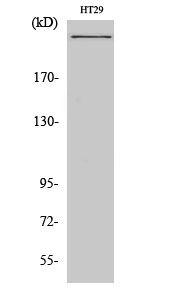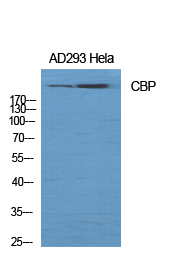

| WB | 咨询技术 | Human,Mouse,Rat |
| IF | 咨询技术 | Human,Mouse,Rat |
| IHC | 1/100-1/300 | Human,Mouse,Rat |
| ICC | 1/200-1/1000 | Human,Mouse,Rat |
| FCM | 咨询技术 | Human,Mouse,Rat |
| Elisa | 1/20000 | Human,Mouse,Rat |
| Aliases | CREBBP; CBP; CREB-binding protein |
| Entrez GeneID | 1387; |
| WB Predicted band size | 265kDa |
| Host/Isotype | Rabbit IgG |
| Antibody Type | Primary antibody |
| Storage | Store at 4°C short term. Aliquot and store at -20°C long term. Avoid freeze/thaw cycles. |
| Species Reactivity | Human,Mouse,Rat |
| Immunogen | Synthesized peptide derived from human CBP around the non-acetylation site of K1535. |
| Formulation | Purified antibody in PBS with 0.05% sodium azide,0.5%BSA and 50% glycerol. |
+ +
以下是关于CBP抗体的3-4篇参考文献示例(注:以下为模拟示例,具体文献需根据实际数据库查询验证):
---
1. **文献名称**:*"CREB-binding protein is a transcriptional coactivator for the adenovirus E1A protein"*
**作者**:Arany, Z., Sellers, W.R., Livingston, D.M., Eckner, R.
**摘要**:该研究揭示了CBP作为腺病毒E1A蛋白的转录共激活因子的作用,通过免疫共沉淀(Co-IP)和Western blot验证了CBP与E1A的直接相互作用,表明其在调控细胞周期和基因表达中的关键功能。
2. **文献名称**:*"Interaction of the transcriptional coactivator CBP with c-Jun and c-Fos requires phosphorylation-dependent acetylation"*
**作者**:Janknecht, R., Nordheim, A.
**摘要**:本文探讨了CBP与转录因子c-Jun/c-Fos的结合机制,发现其依赖于磷酸化介导的乙酰化修饰。通过染色质免疫沉淀(ChIP)和抗体阻断实验,证实了CBP在AP-1复合体调控基因中的必要性。
3. **文献名称**:*"Regulation of TGF-β signaling by CBP subcellular localization and acetyltransferase activity"*
**作者**:Kalkhoven, E., Roijer, E., de Winter, J.P.
**摘要**:研究分析了CBP在TGF-β信号通路中的作用,利用免疫荧光和CBP抗体发现其核质穿梭调控乙酰转移酶活性,进而影响Smad蛋白介导的转录激活。
4. **文献名称**:*"CBP/p300 in cell growth and differentiation: A role in histone acetylation and chromatin remodeling"*
**作者**:Kazantseva, A., Eissenberg, J.C., et al.
**摘要**:该文献系统总结了CBP/p300通过组蛋白乙酰化调控染色质结构和基因表达的机制,抗体在ChIP-seq和功能缺失实验中的应用揭示了其在干细胞分化与肿瘤发生中的双重作用。
---
建议通过PubMed或Google Scholar输入关键词(如“CBP antibody”、“CBP/p300 function”)获取最新及具体应用文献。
**Background of CBP Antibodies**
CBP (CREB-binding protein) is a ubiquitously expressed transcriptional coactivator that plays a central role in regulating gene expression by interacting with multiple transcription factors, including CREB, NF-κB, and nuclear receptors. It functions as a histone acetyltransferase (HAT) through its HAT domain, modifying chromatin structure to enhance transcriptional accessibility. CBP is critical for cellular processes such as differentiation, proliferation, and apoptosis, and its dysregulation is linked to cancers, neurodegenerative disorders, and developmental syndromes like Rubinstein-Taybi syndrome.
CBP antibodies are essential tools for studying its expression, localization, and molecular interactions. They are widely used in techniques like Western blotting, immunoprecipitation (IP), chromatin immunoprecipitation (ChIP), and immunofluorescence (IF) to investigate CBP’s role in signaling pathways (e.g., cAMP, Wnt, and p53) and epigenetic regulation. Specific CBP antibodies target distinct domains (e.g., N-terminal, HAT, or C-terminal regions), enabling researchers to probe functional interactions or post-translational modifications. Validation of these antibodies often involves knockout cell lines or competitive peptides to confirm specificity.
Research applications include exploring CBP’s involvement in diseases, drug discovery targeting HAT activity, and understanding its crosstalk with homologous p300. Due to CBP’s structural and functional overlap with p300. antibodies distinguishing these paralogs are crucial for precise mechanistic studies.
×